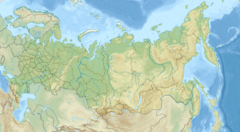
A radio telescope is a specialized antenna and radio receiver used to detect radio waves from astronomical radio sources in the sky. Radio telescopes are the main observing instrument used in radio astronomy, which studies the radio frequency portion of the electromagnetic spectrum emitted by astronomical objects, just as optical telescopes are the main observing instrument used in traditional optical astronomy which studies the light wave portion of the spectrum coming from astronomical objects. Unlike optical telescopes, radio telescopes can be used in the daytime as well as at night.
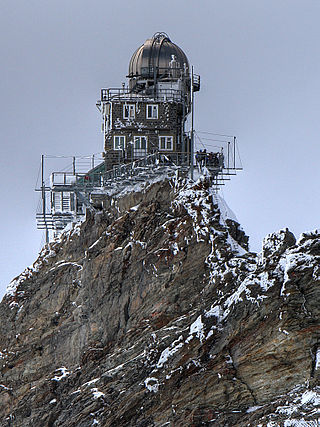
An observatory is a location used for observing terrestrial, marine, or celestial events. Astronomy, climatology/meteorology, geophysics, oceanography and volcanology are examples of disciplines for which observatories have been constructed.

The W. M. Keck Observatory is an astronomical observatory with two telescopes at an elevation of 4,145 meters (13,600 ft) near the summit of Mauna Kea in the U.S. state of Hawaii. Both telescopes have 10 m (33 ft) aperture primary mirrors, and, when completed in 1993 and 1996, they were the largest optical reflecting telescopes in the world. They have been the third and fourth largest since 2006.

The Mount Wilson Observatory (MWO) is an astronomical observatory in Los Angeles County, California, United States. The MWO is located on Mount Wilson, a 5,710-foot (1,740-meter) peak in the San Gabriel Mountains near Pasadena, northeast of Los Angeles.

Owens Valley Radio Observatory (OVRO) is a radio astronomy observatory located near Big Pine, California (US) in Owens Valley. It lies east of the Sierra Nevada, approximately 350 kilometers (220 mi) north of Los Angeles and 20 kilometers (12 mi) southeast of Bishop. It was established in 1956, and is owned and operated by the California Institute of Technology (Caltech). The Owens Valley Solar Array portion of the observatory has been operated by New Jersey Institute of Technology (NJIT) since 1997.

The Paul Wild Observatory, also known as the Narrabri Observatory and Culgoora Observatory, is an astronomical research facility located about 24 km west of Narrabri, New South Wales, Australia. It is the home of the Australia Telescope Compact Array, and the Culgoora Solar Observatory.

The Special Astrophysical Observatory of the Russian Academy of Science is an astronomical observatory, set up in 1966 in the USSR, and now operated by the Russian Academy of Sciences. Based in the Bolshoi Zelenchuk Valley of the Greater Caucasus near the village of Nizhny Arkhyz, the observatory houses the BTA-6 and RATAN-600, an optical and radio telescope, respectively. The two instruments are about 20 km (12 mi) apart.
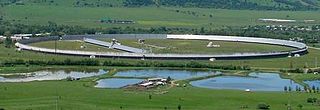
The RATAN-600 is a radio telescope in Zelenchukskaya, Karachay–Cherkess Republic, Russia. It comprises a 576 m diameter circle of rectangular radio reflectors and a set of secondary reflectors and receivers, based at an altitude of 970 m. Each of the 895 2×7.4 m reflectors can be angled to reflect incoming radio waves towards a central conical secondary mirror, or to one of five parabolic cylinders. Each secondary reflector is combined with an instrumentation cabin containing various receivers and instruments. The overall effect is that of a partially steerable antenna with a maximum resolving power of a nearly 600 m diameter dish, when using the central conical receiver, making it the world's largest-diameter individual radio telescope.

Big Bear Solar Observatory (BBSO) is a university-based solar observatory in the United States. It is operated by New Jersey Institute of Technology (NJIT). BBSO has a 1.6-meter (5.2 ft) clear-aperture Goode Solar Telescope (GST), which has no obscuration in the optical train. BBSO is located on the north side of Big Bear Lake in the San Bernardino Mountains of southwestern San Bernardino County, California, approximately 120 kilometers (75 mi) east of downtown Los Angeles. The telescopes and instruments at the observatory are designed and employed specifically for studying the activities and phenomena of the Sun.

A solar telescope or a solar observatory is a special-purpose telescope used to observe the Sun. Solar telescopes usually detect light with wavelengths in, or not far outside, the visible spectrum. Obsolete names for Sun telescopes include heliograph and photoheliograph

The Nobeyama Radio Observatory (NRO) is a division of the National Astronomical Observatory of Japan (NAOJ) and consists of three radio instruments located near Minamimaki, Nagano at an elevation of 1350m.

The Shamakhy Astrophysical Observatory, named after Nasreddin Tusi of the National Academy of Sciences of Azerbaijan was established on November 17, 1959, by decree No. 975 of the Council of Ministers of the Azerbaijan SSR. ShAO operates as a research institute within the ANAS Department of Physical, Mathematical, and Technical Sciences. The Observatory is located in the north-east of the Greater Caucasus Range, 150 km from the city of Baku, in the eastern part of Mount Pirkuli, at an altitude of 1435–1500 m above sea level, in geographical coordinates λ = 48⁰ 35' 04" E, φ = 40⁰ 46 '20"N. Here the number of clear nights suitable for observation reaches 150-180 per year.
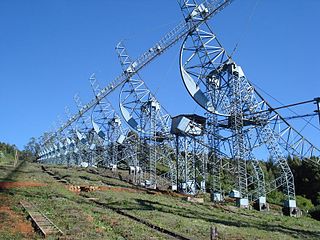
The Ooty Radio Telescope (ORT) is located in Muthorai near Ooty, in South Indian state of Tamil Nadu. It is part of the National Centre for Radio Astrophysics (NCRA) of the Tata Institute of Fundamental Research (TIFR), which is funded by the Government of India through the Department of Atomic Energy. The radio telescope is a 530-metre (1,740 ft) long and 30-metre (98 ft) tall cylindrical parabolic antenna. It operates at a frequency of 326.5 MHz with a maximum bandwidth of 15 MHz at the front end.
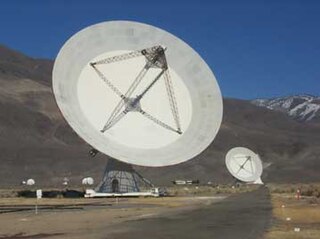
The Owens Valley Solar Array (OVSA), also known as Expanded Owens Valley Solar Array (EOVSA), is an astronomical radio telescope array, located at Owens Valley Radio Observatory (OVRO), near Big Pine, California, with main interests in studying the physics of the Sun. The instruments of the observatory are designed and employed specifically for studying the activities and phenomena of our solar system's sun. Other solar dedicated instruments operated on the site include the Solar Radio Burst Locator (SRBL), the FASR Subsystem Testbed (FST), and the Korean SRBL (KSRBL). The OVSA is operated by the New Jersey Institute of Technology (NJIT), which also operates the Big Bear Solar Observatory.

The Gauribidanur Radio Observatory is a radio telescope observatory located at Gauribidanur, near Bengaluru. It is operated jointly by Raman Research Institute and the Indian Institute of Astrophysics. The observatory has been in operation since 1976.

The Chinese Deep Space Network (CDSN) is a network of large antennas and communication facilities that are used for radio astronomy, radar observations, and spacecraft missions of China. The CDSN is managed by the China Satellite Launch and Tracking Control Center General (CLTC) of the People's Liberation Army Strategic Support Force Space Systems Department.

The POlarization Emission of Millimeter Activity at the Sun (POEMAS) is a solar patrol system composed of two radio telescopes with superheterodyne circular polarization receivers at 45 and 90 GHz. Since their half power beam width is around 1.4°, they observe the full sun. The acquisition system allows to gather 100 values per second at both frequencies and polarizations, with a sensitivity of around 20 solar flux units (SFU) (1 SFU ≡ 104 Jy). The telescope saw first light in November 2011, and showed excellent performance during two years, when it observed many flares. Since November 2013 is stopped for repairing. The main interest of POEMAS is the observation of solar flares in a frequency range where there are very few detectors and fill the gap between microwaves observed with the Radio Solar Telescope Network (1 to 15.4 GHz) and submillimeter observations of the Solar Submillimeter Telescope (212 and 405 GHz). Moreover, POEMAS is the only current telescope capable of carrying on circular polarization solar flare observations at 90 GHz. (Although, in principle, ALMA band 3 may also observe at 90 GHz with circular polarization).
Solar radio emission refers to radio waves that are naturally produced by the Sun, primarily from the lower and upper layers of the atmosphere called the chromosphere and corona, respectively. The Sun produces radio emissions through four known mechanisms, each of which operates primarily by converting the energy of moving electrons into electromagnetic radiation. The four emission mechanisms are thermal bremsstrahlung (braking) emission, gyromagnetic emission, plasma emission, and electron-cyclotron maser emission. The first two are incoherent mechanisms, which means that they are the summation of radiation generated independently by many individual particles. These mechanisms are primarily responsible for the persistent "background" emissions that slowly vary as structures in the atmosphere evolve. The latter two processes are coherent mechanisms, which refers to special cases where radiation is efficiently produced at a particular set of frequencies. Coherent mechanisms can produce much larger brightness temperatures (intensities) and are primarily responsible for the intense spikes of radiation called solar radio bursts, which are byproducts of the same processes that lead to other forms of solar activity like solar flares and coronal mass ejections.

